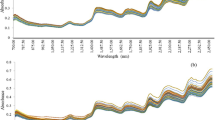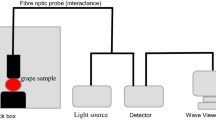Abstract
Agro-food industries require sustainable and profitable alternatives to disposal of their by-products. Grape pomace is a winemaking residue that represents a low-cost natural source of phenolic compounds with recognized antioxidant properties. In this work, Fourier-transform near-infrared (FT-NIR) spectroscopy and chemometric analysis were exploited to the characterization of red grape pomace composition (content of seeds and skins) and chemical properties as total phenolic content (TPC) and total antioxidant capacity (TAC). Raw (n = 96) and milled (n = 96) samples were evaluated by NIR spectroscopy and by classical batchwise assays, Folin-Ciocalteu, and ABTS for TPC and TAC, respectively, after different storage times (1 week to 2 months). Grape seeds had higher levels of TPC and TAC per sample dry weight when compared to grape skins. FT-NIR spectra of raw and milled samples were calibrated against content (%) of skins and seeds, TPC, and TAC using partial least squares (PLS) modeling. Spectral wavelength selection and latent variables were optimized for the lowest root-mean-square errors. PLS models’ results showed higher linearity for milled samples (0.936 > R 2 > 0.914) when compared to raw samples (0.885 > R 2 > 0.928). The range error ratio (RER) was between 10 and 14 for raw samples, while for milled grape pomace, it ranged from 15 to 18. Results confirmed that NIR spectroscopy can be applied to winemaking residues with virtually no sample processing needed to estimate the content of grape seeds and skins, the total phenolics, and total antioxidant capacity. Therefore, FT-NIR technique represents a non-destructive and eco-friendly technique to foster added value of grape pomace residues before time-consuming extraction steps are performed.





Similar content being viewed by others
References
Bao, Y. D., Liu, F., Kong, W. W., Sun, D. W., He, Y., & Qiu, Z. J. (2014). Measurement of soluble solid contents and pH of white vinegars using VIS/NIR spectroscopy and least squares support vector machine. Food and Bioprocess Technology, 7(1), 54–61.
Bokobza L. (1998). Near infrared spectroscopy. Journal of near Infrared Spectroscopy, Vol 6 1998. Nir Publications, Chichester.
Burns, D. A., & Ciurczak, E. W. (2008). Book of near-infrared analysis. Boca Raton, FL: CRC.
Chouchouli, V., Kalogeropoulos, N., Konteles, S. J., Karvela, E., Makris, D. P., & Karathanos, V. T. (2013). Fortification of yoghurts with grape (Vitis vinifera) seed extracts. LWT--Food Science and Technology, 53(2), 522–529.
Cornell J. (2002). The Original mixture problem: designs and models for exploring the entire simplex factor space. In: Experiments with mixtures: Designs, models, and the analysis of mixture data. p^pp. Wiley, NY.
De Girolamo, A., Lippolis, V., Nordkvist, E., & Visconti, A. (2009). Rapid and non-invasive analysis of deoxynivalenol in durum and common wheat by Fourier-transform near infrared (FT-NIR) spectroscopy. Food Additives and Contaminants Part a-Chemistry Analysis Control Exposure & Risk Assessment, 26(6), 907–917.
Devesa-Rey, R., Vecino, X., Varela-Alende, J. L., Barral, M. T., Cruz, J. M., & Moldes, A. B. (2011). Valorization of winery waste vs. the costs of not recycling. Waste Management, 31(11), 2327–2335.
dos Santos, C. A. T., Lopo, M., Pascoa, R., & Lopes, J. A. (2013). A review on the applications of portable near-infrared spectrometers in the agro-food industry. Applied Spectroscopy, 67(11), 1215–1233.
Ferrer-Gallego, R., Hernandez-Hierro, J. M., Rivas-Gonzalo, J. C., & Escribano-Bailon, M. T. (2010). Feasibility study on the use of near infrared spectroscopy to determine flavanols in grape seeds. Talanta, 82(5), 1778–1783.
Fontana, A. R., Antoniolli, A., & Bottini, R. (2013). Grape pomace as a sustainable source of bioactive compounds: extraction, characterization, and biotechnological applications of phenolics. Journal of Agricultural and Food Chemistry, 61(38), 8987–9003.
Garrido, M. D., Auqui, M., Marti, N., & Linares, M. B. (2011). Effect of two different red grape pomace extracts obtained under different extraction systems on meat quality of pork burgers. LWT--Food Science and Technology, 44(10), 2238–2243.
Geladi, P., & Kowalski, B. R. (1986). Partial least-squares regression - a tutorial. Analytica Chimica Acta, 185, 1–17.
Gonzalez-Centeno, M. R., Jourdes, M., Femenia, A., Simal, S., Rossello, C., & Teissedre, P.-L. (2013). Characterization of polyphenols and antioxidant potential of white grape pomace byproducts (Vitis vinifera L.). Journal of Agricultural and Food Chemistry, 61(47), 11579–11587.
Gonzalez-Paramas, A. M., Esteban-Ruano, S., Santos-Buelga, C., De Pascual-Teresa, S., & Rivas-Gonzalo, J. C. (2004). Flavanol content and antioxidant activity in winery byproducts. Journal of Agricultural and Food Chemistry, 52(2), 234–238.
Horizon2020 http://ec.europa.eu/programmes/horizon2020/en/area/food-healthy-diet. Accessed 17 April 2014
Kuligowski, J., Carrion, D., Quintas, G., Garrigues, S., & de la Guardia, M. (2012). Direct determination of polymerised triacylglycerides in deep-frying vegetable oil by near infrared spectroscopy using partial least squares regression. Food Chemistry, 131(1), 353–359.
Lafka, T. I., Sinanoglou, V., & Lazos, E. S. (2007). On the extraction and antioxidant activity of phenolic compounds from winery wastes. Food Chemistry, 104(3), 1206–1214.
Lorenzo, J. M., Sineiro, J., Amado, I. R., & Franco, D. (2014). Influence of natural extracts on the shelf life of modified atmosphere-packaged pork patties. Meat Science, 96(1), 526–534.
Magalhães, L. M., Barreiros, L., Maia, M. A., Reis, S., & Segundo, M. A. (2012). Rapid assessment of endpoint antioxidant capacity of red wines through microchemical methods using a kinetic matching approach. Talanta, 97, 473–483.
Makris, D. P., Boskou, G., & Andrikopoulos, N. K. (2007). Polyphenolic content and in vitro antioxidant characteristics of wine industry and other agri-food solid waste extracts. Journal of Food Composition and Analysis, 20(2), 125–132.
Mildner-Szkudlarz, S., Zawirska-Wojtasiak, R., Szwengiel, A., & Pacynski, M. (2011). Use of grape by-product as a source of dietary fibre and phenolic compounds in sourdough mixed rye bread. International Journal of Food Science and Technology, 46(7), 1485–1493.
Naes T., Isaksson T., Fearn T., Davies T. (2004). Interpreting PCR and PLS solutions. In: A User-Friendly Guide to Multivariate Calibration and Classification. NIR Publications, Chichester, UK
Paradelo, R., Moldes, A. B., & Barral, M. T. (2009). Treatment of red wine vinasses with non-conventional substrates for removing coloured compounds. Water Science and Technology, 59(8), 1585–1592.
Parreira, T. F., Ferreira, M. M. C., Sales, H. J. S., & de Almeida, W. B. (2002). Quantitative determination of epoxidized soybean oil using near-infrared spectroscopy and multivariate calibration. Applied Spectroscopy, 56(12), 1607–1614.
Páscoa, R. N. M. J., Magalhães, L. M., & Lopes, J. A. (2013). FT-NIR spectroscopy as a tool for valorization of spent coffee grounds: application to assessment of antioxidant properties. Food Research International, 51(2), 579–586.
Peralbo-Molina, A., & de Castro, M. D. L. (2013). Potential of residues from the Mediterranean agriculture and agrifood industry. Trends in Food Science & Technology, 32(1), 16–24.
Ping, L., Brosse, N., Chrusciel, L., Navarrete, P., & Pizzi, A. (2011). Extraction of condensed tannins from grape pomace for use as wood adhesives. Industrial Crops and Products, 33(1), 253–257.
Queji, M. D., Wosiacki, G., Cordeiro, G. A., Peralta-Zamora, P. G., & Nagata, N. (2010). Determination of simple sugars, malic acid and total phenolic compounds in apple pomace by infrared spectroscopy and PLSR. International Journal of Food Science and Technology, 45(3), 602–609.
Rambo, M. K. D., Amorim, E. P., & Ferreira, M. M. C. (2013). Potential of visible-near infrared spectroscopy combined with chemometrics for analysis of some constituents of coffee and banana residues. Analytica Chimica Acta, 775, 41–49.
Rinnan, A., van den Berg, F., & Engelsen, S. B. (2009). Review of the most common pre-processing techniques for near-infrared spectra. Trac-Trends in Analytical Chemistry, 28(10), 1201–1222.
Rivera, O. M. P., Moldes, A. B., Torrado, A. M., & Dominguez, J. M. (2007). Lactic acid and biosurfactants production from hydrolyzed distilled grape marc. Process Biochemistry, 42(6), 1010–1020.
Rockenbach, I. I., Gonzaga, L. V., Rizelio, V. M., Goncalves, A., Genovese, M. I., & Fett, R. (2011a). Phenolic compounds and antioxidant activity of seed and skin extracts of red grape (Vitis vinifera and Vitis labrusca) pomace from Brazilian winemaking. Food Research International, 44(4), 897–901.
Rockenbach, I. I., Rodrigues, E., Gonzaga, L. V., Caliari, V., Genovese, M. I., Goncalves, A., & Fett, R. (2011b). Phenolic compounds content and antioxidant activity in pomace from selected red grapes (Vitis vinifera L. and Vitis labrusca L.) widely produced in Brazil. Food Chemistry, 127(1), 174–179.
Rodriguez, L. A., Toro, M. E., Vazquez, F., Correa-Daneri, M. L., Gouiric, S. C., & Vallejo, M. D. (2010). Bioethanol production from grape and sugar beet pomaces by solid-state fermentation. International Journal of Hydrogen Energy, 35(11), 5914–5917.
Sant’Anna, V., Brandelli, A., Marczak, L. D. F., & Tessaro, I. C. (2012). Kinetic modeling of total polyphenol extraction from grape marc and characterization of the extracts. Separation and Purification Technology, 100, 82–87.
Sarraguca, M. C., Santos, J. R., Rangel, A., & Lopes, J. A. (2013). Authenticity control of roasted coffee brands using near-infrared spectroscopy. Food Analytical Methods, 6(3), 892–899.
Selani, M. M., Contreras-Castillo, C. J., Shirahigue, L. D., Gallo, C. R., Plata-Oviedo, M., & Montes-Villanueva, N. D. (2011). Wine industry residues extracts as natural antioxidants in raw and cooked chicken meat during frozen storage. Meat Science, 88(3), 397–403.
Sessa, M., Casazza, A. A., Perego, P., Tsao, R., Ferrari, G., & Donsi, F. (2013). Exploitation of polyphenolic extracts from grape marc as natural antioxidants by encapsulation in lipid-based nanodelivery systems. Food and Bioprocess Technology, 6(10), 2609–2620.
Soukupova, J., Rock, B. N., & Albrechtova, J. (2002). Spectral characteristics of lignin and soluble phenolics in the near infrared—a comparative study. International Journal of Remote Sensing, 23(15), 3039–3055.
Spatafora, C., Barbagallo, E., Amico, V., & Tringali, C. (2013). Grape stems from Sicilian Vitis vinifera cultivars as a source of polyphenol-enriched fractions with enhanced antioxidant activity. LWT--Food Science and Technology, 54(2), 542–548.
Spigno, G., & Faveri, D. M. (2007). Antioxidants from grape stalks and marc: Influence of extraction procedure on yield, purity and antioxidant power of the extracts. Journal of Food Engineering, 78(3), 793–801.
Torchio, F., Segade, S. R., Giacosa, S., Gerbi, V., & Rolle, L. (2013). Effect of growing zone and vintage on the prediction of extractable flavanols in winegrape seeds by a FT-NIR method. Journal of Agricultural and Food Chemistry, 61(38), 9076–9088.
Ziemons, E., Mantanus, J., Lebrun, P., Rozet, E., Evrard, B., & Hubert, P. (2010). Acetaminophen determination in low-dose pharmaceutical syrup by NIR spectroscopy. Journal of Pharmaceutical and Biomedical Analysis, 53(3), 510–516.
Acknowledgments
L. M. Magalhães and J. A. Lopes thank Fundo Social Europeu (FSE) and Ministério da Ciência, Tecnologia e Ensino Superior (MCTES) for the financial support through the POPH-QREN program. Ricardo N.M.J. Páscoa thanks Fundação para a Ciência e a Tecnologia (FCT) for the financial support through the Grant SFRH/BPD/81384/2011. We also acknowledge the financial support from the European Union (FEDER funds through COMPETE) and National Funds (FCT, Fundação para a Ciência e Tecnologia) through project Pest-C/EQB/LA0006/2013.
Author information
Authors and Affiliations
Corresponding author
Electronic supplementary material
Below is the link to the electronic supplementary material.
ESM 1
(DOCX 746 kb)
Rights and permissions
About this article
Cite this article
Páscoa, R.N.M.J., Machado, S., Magalhães, L.M. et al. Value Adding to Red Grape Pomace Exploiting Eco-friendly FT-NIR Spectroscopy Technique. Food Bioprocess Technol 8, 865–874 (2015). https://doi.org/10.1007/s11947-014-1454-z
Received:
Accepted:
Published:
Issue Date:
DOI: https://doi.org/10.1007/s11947-014-1454-z




